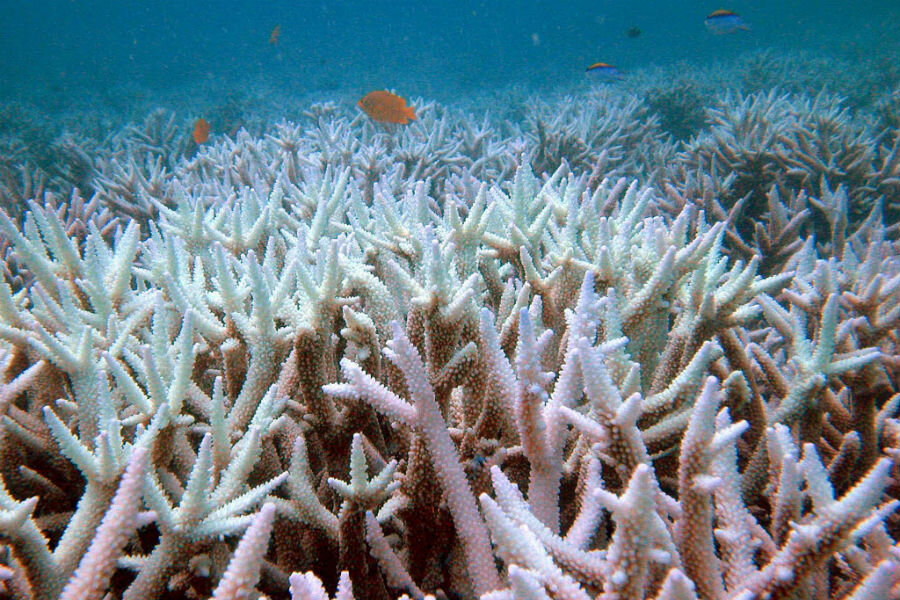Study may help scientists identify which coral reefs can be saved
Loading...
With the world's oceans on the verge of what may be a year of significant coral bleaching, researchers have devised a simple way of predicting which reefs stand the best chance of recovery from a climate-triggered bleaching event.
The study, led by Australian marine scientists Nicholas Graham, Aaron MacNeil, and Shaun Wilson, come at a time when concerns are mounting among some reef specialists that a persistent buildup of warm surface waters in the western tropical Pacific could spark a significant bleaching event approaching the scale not seen since the late 1990s – the likes of which no one had seen before.
Reefs worldwide host some 25 percent of all marine species and serve as protective nurseries for newborn fish and other forms of marine life. They also serve as a first line of defense from storm surge for coastal communities and through fishing provide the main source of protein in the diets of more than 500 million people.
Coral bleaching in effect represents a serious breakdown in landlord-tenant relations.
Coral reefs grow out of a tightly knit partnership between clear organisms known as coral polyps and tiny algae that inhabit cells that line the polyps' digestive system. The polyps protect the algae and provide them with the carbon dioxide they need for photosynthesis, as well as with other nutrients the polyps eject as waste. The algae provide organic compounds polyps need to survive and to produce calcium carbonate, which builds up a reef's structure. The algae are the flashy dressers, lending the polyps their unique colors.
When pollution, excessively warm water, or other stresses – by themselves or together – affect the polyps, however, the polyp-algae relationship dissolves. The polyps expel the algae. The corals turn white. If the stresses are too intense or last too long, the coral dies.
The stresses, including heat, have been well documented, researchers say. That's not the case, however, for factors that contribute to recovery.
Many factors, such as levels of pollution, the makeup of fish populations, and the abundance of baby corals can also influence the outcomes. Where possible, these should still be taken into account for recovery forecasts, the researchers say.
But if all you have to work with are depth and reef complexity, they can still give you a good bead on the likelihood that a reef will recover from climate-related bleaching, the team found.
The team conducting the reef-resilience study says its approach could help coastal-resource managers identify which reefs to add to their must-conserve lists. It also could help identify coastal communities that should start planning for the potential long-term loss of productivity from their offshore reefs if they appear to fall among the least likely to succeed.
The assertions of potential usefulness draw an enthusiastic nod from Stephanie Wear, the lead scientist for coral reef conservation at The Nature Conservancy, based in Arlington, Va.
Despite some of the doomsday scenarios for reefs that arose in the immediate aftermath of the 1997-'98 bleaching event it soon became clear that not all reefs responded in the same way, Ms. Wear says.
Instead, the scientific question became: "What are the factors that contribute to resistance to bleaching and to resilience – that ability to recover and return to what they were prior to the event," she explains.
By identifying two simple factors that contribute to a reef's recovery and appear to be powerful predictors of which reefs are most likely to recover, the researchers have accomplished something "extraordinarily important," she says. These are simple metrics that even the most cash-strapped conservation managers can apply.
In an effort to better understand the factors contributing to reef resilience, Dr. Graham and colleagues analyzed a wealth of data from reefs in the Republic of Seychelles, a group of islands that dot the Indian Ocean. Bleaching hit the Seychelles particularly hard during the ’97-’98 event, erasing more than 90 percent of the region’s live-coral cover.
Yet of the 21 reefs Graham and colleagues analyzed, only nine underwent a wholesale ecological overhaul that led to unproductive reefs. The other 12 were firmly on the road to recovery, with an average 23 percent of these reefs covered with live corals by 2011. On average, a healthy reef will have about 40 percent live-coral cover.
This in itself was surprising, Graham notes in an e-mail.
"Such divergent responses within a single reef system have not been documented before, but were very clear here," he writes.
Then the team analyzed data that covered some 2,500 square miles of reef habitat and included before-and-after information on 11 factors affecting reef health. Among them: reef complexity, depth, the density of plant-eating fish, the density of baby coral polyps, nutrient levels in the seawater, wave action, even whether or not the reef was part of a marine protected area.
Using detailed statistical tools, the researchers gauged the influence of each factor on recovery to pre-bleaching status. While all had some influence on the outcome, the researchers found that they could successfully predict a reef's recovery trajectory 98 percent of the time using only depth and reef complexity.
That, Graham writes, was the second major surprise. Prior research had documented the influence of some of these factors on reef health. But the influence of depth and complexity on resilience "were quite novel."
At the moment, it's unclear why this is the case, Graham notes. One possibility: the amount of light reaching deeper, more complex reefs is insufficient to support the density of macroalgae that gather on bleached reefs at shallower depths.
Whatever the reasons, the two factors are influential on reefs in other parts of the Indo-Pacific region, the team notes. The team applied them to reefs off of Kenya, Tanzania, the Maldives, the Chagos Archipelago, Australia's Great Barrier Reef, and Fiji, with comparable predictive results.
The findings are set to appear in Thursday's issue of the journal Nature.






